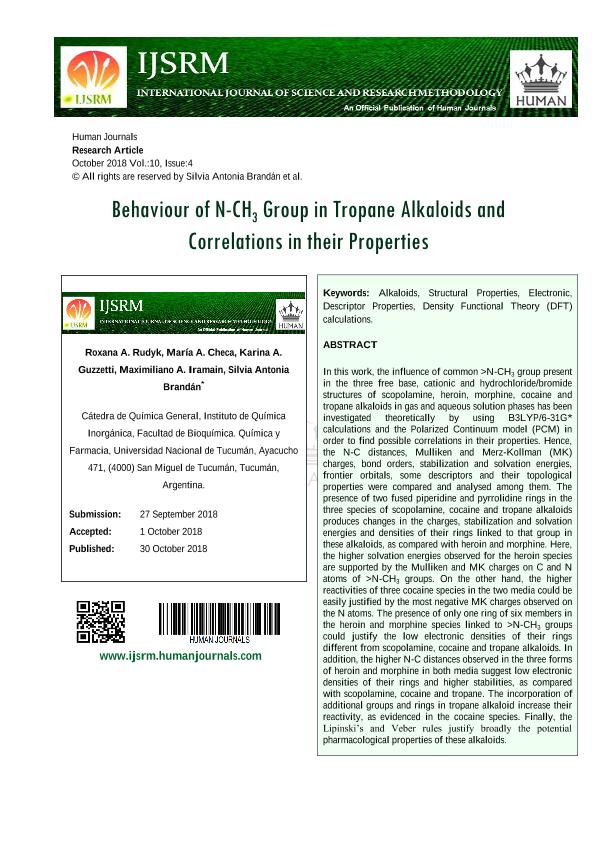Artículo
Behaviour of N-CH3 Group in Tropane Alkaloids and Correlations in their Properties
Rudyk, Roxana Amelia; Checa, Maria Alejandra; Guzetti, Karina; Iramain, Maximiliano Alberto ; Brandan, Silvia Antonia
; Brandan, Silvia Antonia
 ; Brandan, Silvia Antonia
; Brandan, Silvia Antonia
Fecha de publicación:
10/2018
Editorial:
Paripex
Revista:
Indian Journal of Research
ISSN:
2250-1991
Idioma:
Inglés
Tipo de recurso:
Artículo publicado
Clasificación temática:
Resumen
In this work, the influence of common >N-CH3 group present in the three free base, cationic and hydrochloride/bromide structures of scopolamine, heroin, morphine, cocaine and tropane alkaloids in gas and aqueous solution phases has been investigated theoretically by using B3LYP/6-31G* calculations and the Polarized Continuum model (PCM) in order to find possible correlations in their properties. Hence, the N-C distances, Mulliken and Merz-Kollman (MK) charges, bond orders, stabilization and solvation energies, frontier orbitals, some descriptors and their topological properties were compared and analysed among them. The presence of two fused piperidine and pyrrolidine rings in the three species of scopolamine, cocaine and tropane alkaloids produces changes in the charges, stabilization and solvation energies and densities of their rings linked to that group in these alkaloids, as compared with heroin and morphine. Here, the higher solvation energies observed for the heroin species are supported by the Mulliken and MK charges on C and N atoms of >N-CH3 groups. On the other hand, the higher reactivities of three cocaine species in the two media could be easily justified by the most negative MK charges observed on the N atoms. The presence of only one ring of six members in the heroin and morphine species linked to >N-CH3 groups could justify the low electronic densities of their rings different from scopolamine, cocaine and tropane alkaloids. In addition, the higher N-C distances observed in the three forms of heroin and morphine in both media suggest low electronic densities of their rings and higher stabilities, as compared with scopolamine, cocaine and tropane. The incorporation of additional groups and rings in tropane alkaloid increase their reactivity, as evidenced in the cocaine species. Finally, the Lipinski’s and Veber rules justify broadly the potential pharmacological properties of these alkaloids
Palabras clave:
ALKALOIDS
,
STRUCTURAL PROPERTIES
,
DESCRIPTORS
,
DFT CALCULATIONS
Archivos asociados
Licencia
Identificadores
Colecciones
Articulos(CCT - NOA SUR)
Articulos de CTRO.CIENTIFICO TECNOL.CONICET - NOA SUR
Articulos de CTRO.CIENTIFICO TECNOL.CONICET - NOA SUR
Citación
Rudyk, Roxana Amelia; Checa, Maria Alejandra; Guzetti, Karina; Iramain, Maximiliano Alberto; Brandan, Silvia Antonia; Behaviour of N-CH3 Group in Tropane Alkaloids and Correlations in their Properties; Paripex; Indian Journal of Research; 10; 4; 10-2018; 70-97
Compartir



